10 Wind Energy Facts and Statistics to Know in 2025
-
Pete Ortiz
- Last updated:

Note: This article’s statistics come from third-party sources and do not represent the opinions of this website.
You may have seen the massive wind turbines in the countryside. But did you know a lot of them are turning in our favor? Do you also know that wind energy is the fastest-growing renewable energy?
It’s true. Not only is wind energy a clean alternative to coal and other fossil fuels, but it’s also cheaper than other types of energy today!
Thanks to renewable energy and environmental advances, the world’s consumption of fossil fuels have been on the decline. Besides, nations everywhere are striving to produce sustainable power. Using renewable resources to produce clean, efficient, and reliable wind energy has become a popular movement for many countries globally.
It’s not surprising when you consider some of the staggering wind energy facts and statistics available as seen in this article.
Click below to jump ahead:
- Benefits of Wind Energy
- Amount of Wind Energy Produced
- Regions Where Wind Energy is used Most
- Wind Turbines Heights and Turbine Technician Wages
The 10 Wind Energy Facts and Statistics
- Wind energy helps avoid 305 million metric tons of CO2 (carbon dioxide) emissions in the US annually.
- The wind industry in the US employs approximately 120,000 full-time workers every year.
- The wind industry in the US employs veterans at a rate of 67% more than the national average.
- Wind power increases by 20% (an overwhelming 60.4 gigawatts) globally every year.
- The cumulative capacity of installed wind power globally is 743 gigawatts.
- A wind turbine rated 1.5 MW generates about 3,285,000 kWh of electricity annually. It’s sufficient to power 500 homes every year.
- Iowa generates 57% of its electricity from wind annually. It has the second-highest annual wind energy generation in the US.
- Wind power has surpassed hydroelectric power as the most used renewable electricity generation source in the United States.
- The average annual wage of wind turbine technicians in the US is $56,230.
- Wind speeds are faster at higher altitudes and slower close to the earth’s surface. That’s why the average hub height of contemporary wind turbines is 90 meters.
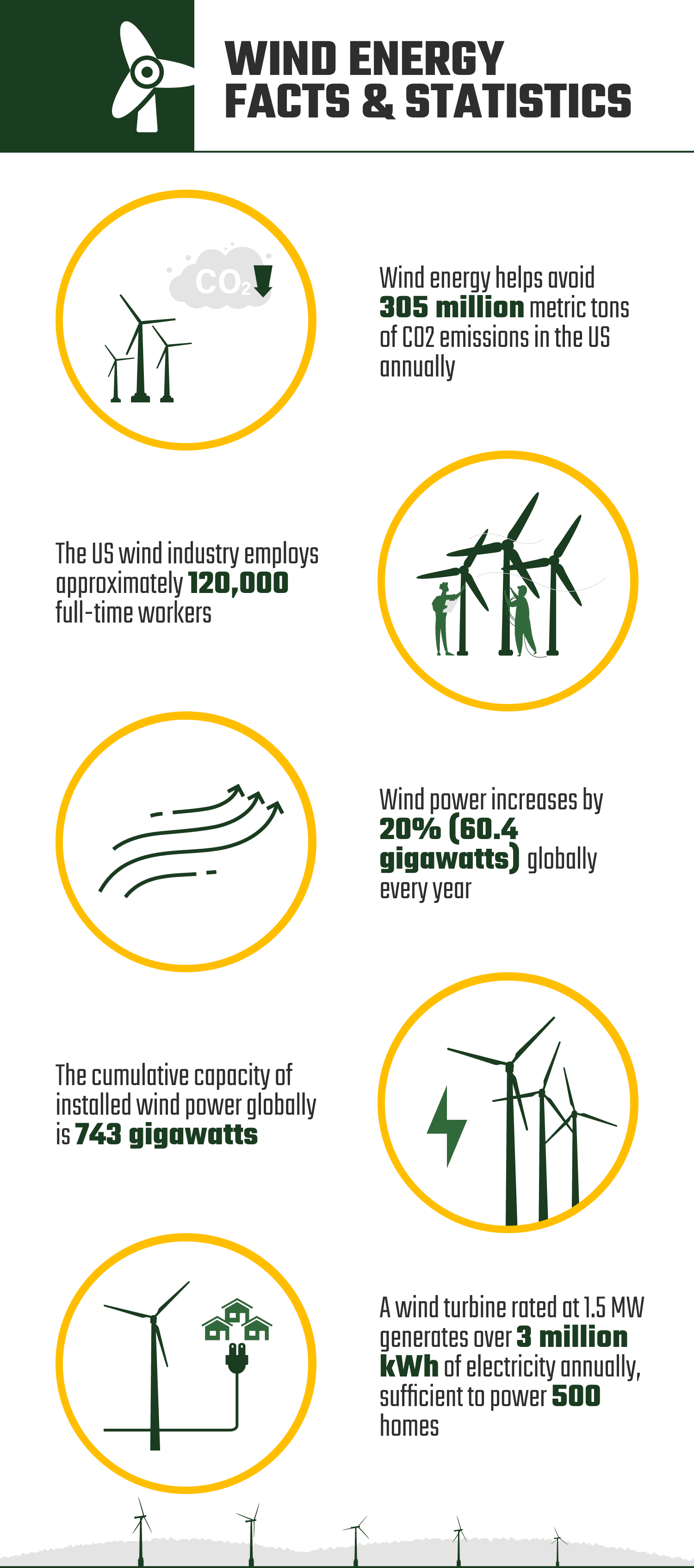
Benefits of Wind Energy
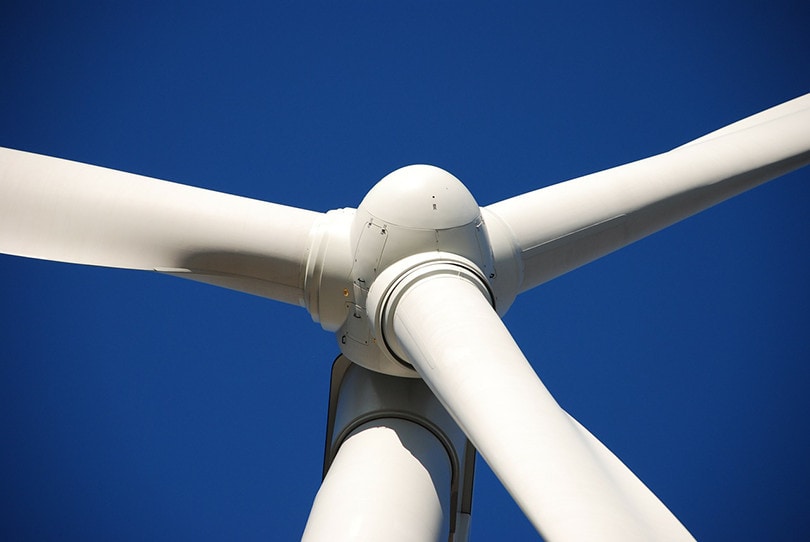
1. Wind energy helps avoid 305 million metric tons of CO2 (carbon dioxide) emissions in the US annually.
(CLEAN POWER)
The primary benefit of wind energy is its ability to avoid pollution from fossil fuel sources. Fossil fuels emit various pollutants that are known to cause serious health problems and contribute to climate change. Wind energy is a clean power source that reduces carbon dioxide emissions to the environment.
The wind industry has continued innovation to meet the ever-increasing demand for clean, affordable, and reliable electricity while reducing environmental impacts.
2. The wind industry in the US employs approximately 120,000 full-time workers every year.
(CSS)
The wind industry creates tens of thousands of part-time and full-time jobs each year in the US. Many of these jobs are directly in the wind energy field. The jobs are spread out over various locations because wind power is distributed across the country.
The work performed by these employees is diverse, ranging from manufacturing turbine parts to providing technical support for turbine installations.
The wind industry also generates millions of dollars in tax revenue and landowner lease payments to counties and states.
3. The wind industry in the US employs veterans at a rate of 67% more than the national average.
(CLEAN GRID ALLIANCE)
The US has a large population of veterans, and coincidentally there is high demand for wind turbine technicians. Veterans are a crucial part of the US wind industry, well-suited for a career in the wind industry given the skills, training, and leadership that they have acquired during their service,
Tapping into veteran talent is one way that the wind industry is helping address a critical national issue: creating new jobs. Finding a job after returning home can be challenging for many veterans.
This field has the potential to provide long-term employment opportunities.
 Amount of Wind Energy Produced
Amount of Wind Energy Produced
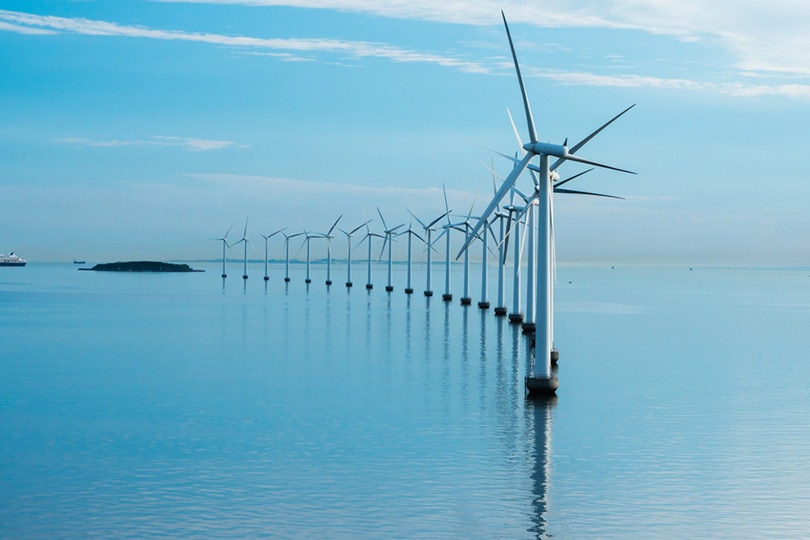
4. Wind power increases by 20% (an overwhelming 60.4 gigawatts) globally every year.
(INSPIRE CLEAN ENERGY)
Wind energy is a fast-growing source of alternative energy. Thanks to advances in technology and improvements in wind turbine efficiency, the world is producing more power from wind than ever before.
The reduced cost of wind energy is making it easier for countries to install new wind power facilities. It brings down the price of generating renewable energy worldwide.
The continued development of this industry will help create more jobs. Also, it’ll make the transition to renewable energy sources easier for those who are yet to make the jump.
5. The cumulative capacity of installed wind power globally is 743 gigawatts.
(STATISTA)
Wind power works best in areas with consistent wind and few obstructions. It can be used with other sources of electricity to create a more reliable power supply making an excellent alternative for a clean energy source.
But still it makes up only a fraction of the world’s electricity supply. With China leading the way, it’s no wonder that Asia has the largest cumulative installed wind power capacity.
There has been much discussion about expanding the use of wind energy globally. There are several ways to accomplish this such as building more turbines in areas with ample wind and wind farms.
6. A wind turbine rated 1.5 MW generates about 3,285,000 kWh of electricity annually. It’s sufficient to power 500 homes every year.
(INSPIRE CLEAN ENERGY)
A 1.5 MW wind turbine is the perfect size for a small community or a large farm as it can produce around 3,285,000 kWh of electricity every year. This is enough energy to power homes and other buildings in places where utility companies don’t have access. Some of these areas are remote and isolated, and distributing other forms of energy would be too costly.
Usually, the wind energy generated by a wind turbine relies on how much wind it can catch and how efficiently it can convert that energy into electricity.
These days, many companies are offering their customers wind turbines to generate clean energy. The efficiency rate of these turbines is relatively high, and they aren’t expensive either.
 Regions Where Wind Energy is used Most
Regions Where Wind Energy is used Most

7. Iowa generates 57% of its electricity from wind annually. It has the second-highest annual wind energy generation in the US.
(CSS)
The state of Iowa is the second-largest producer of wind power in the US, after Texas. In fact, most of the state’s electricity comes from wind.
Turbines are erected across the state for optimal efficiency. Iowa’s prime location in the center of the country makes it an ideal place to host a wind farm.
Most of the turbines are located on land that has been reclaimed through conservation efforts or agricultural practices such as crop rotation and strip-cropping.
8. Wind power has surpassed hydroelectric power as the most used renewable electricity generation source in the United States.
(EIA)
The US is among the leading authorities in the adoption of clean energy technology. So far, wind energy surpasses hydroelectric power use.
The fast growth of wind energy in the United States is due to various factors including state and federal policies and technological advancements that have made wind power more economically competitive.
Technology has improved the design and efficiency of wind turbines, and policy changes have made it easier for businesses to invest in wind farms.
The increase in electricity generation from wind power has been essential in helping the country meet current federal regulations.
 Wind Turbines Heights and Turbine Technician Wages
Wind Turbines Heights and Turbine Technician Wages
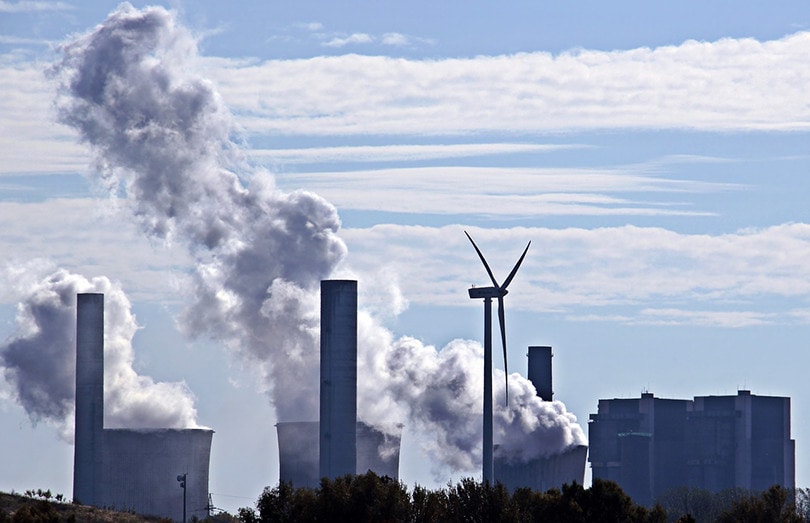
9. The average annual wage of wind turbine technicians in the US is $56,230.
(BLS)
Wind turbine technicians are employed by electric power generation companies. They earn a good salary averaging to $56,230 annually. Most of them work on wind farms that generate electricity using turbines.
To be successful in this career, you’ll need to have mechanical aptitude and an understanding of electricity and electronics.
Turbine technicians work on the mechanical and electrical components of large wind turbines. They inspect and repair turbines, adjust and balance blades, and perform routine maintenance.
10. Wind speeds are faster at higher altitudes and slower close to the earth’s surface. That’s why the average hub height of contemporary wind turbines is 90 meters.
(ENERGY)
The higher the turbine, the more power it generates. Measuring the wind speed at different heights is essential when erecting modern wind turbines. The average hub height of wind turbines is about 90 meters.
That’s where the highest average wind speeds can be found. The hub height of a wind turbine is defined as the height of the rotating axis (rotor) from the ground to the rotor center. It’s synonymous with tower height or total height.
Frequently Asked Questions on Wind Energy
How efficient are wind turbines?
Wind turbines convert wind energy into electrical energy. The turbines have three key components: a generator, a gearbox, and a tower.
The wind turns the rotor blades connected by gears to the generator. Then, the generator generates electricity. A gearbox transfers this power to the transmission line.
Usually, wind turbines produce more power at higher wind speeds than conventional generators do, but not all winds are created equal. Winds in the upper atmosphere are less turbulent than winds closer to the earth’s surface.
(EPA)
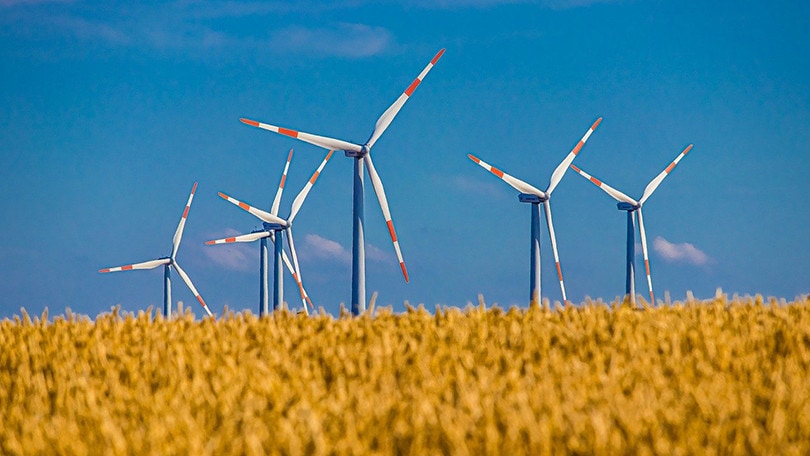
What is a wind farm?
Wind farms are large-scale energy production facilities, a common sight in many parts of the world. They comprise large systems of wind turbines, which convert energy from the wind into electrical power.
They can produce a substantial amount of electricity over a long period. A wind farm provides enough electricity to power anything between a few thousand homes to a city or even an entire country.
(WONDER OPOLIS)
What are the benefits of wind energy?
Wind power is an eco-friendly source of electricity on the planet. Wind turbines generate power with no carbon emissions, pollution, or other forms of hazardous waste.
Wind energy is also abundant. The wind doesn’t experience seasonal changes and it’s always present in some capacity, making it a more reliable source of power.
Turbines are also quiet, producing just a low hum, hence substantially less disruptive to animal life than other forms of energy generation such as coal mining and oil drilling. However, it can be a bother to people living around.
They also don’t require a large amount of land area like some forms of hydroelectricity do.
The low cost of wind power can also be attractive to consumers. The cost to produce electricity from wind has decreased over time and often runs lower than the cost of coal or nuclear-based energy.
Some countries are now providing financial incentives for using renewable energy sources such as wind. These incentives have been effective in increasing the use of wind power in many countries globally.
(ENERGY)
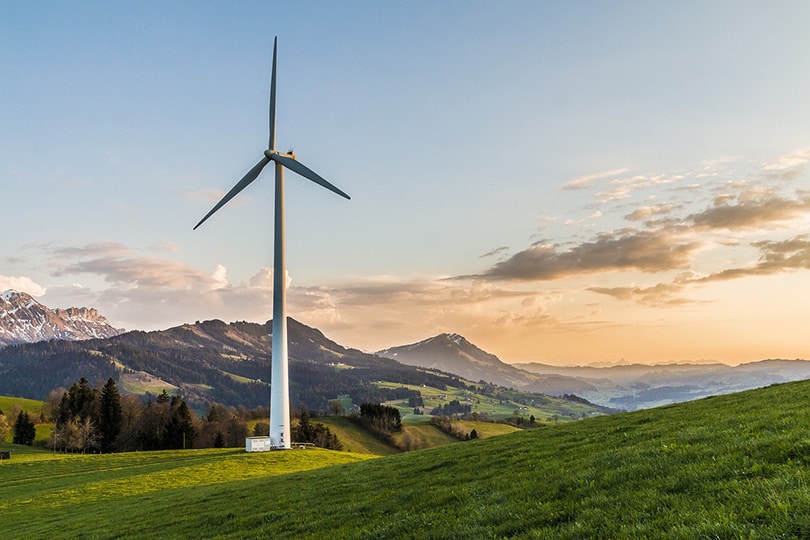
Related Read: How Many Homes Can a Wind Turbine Power? What You Need To Know!
What are the drawbacks of wind energy?
Wind turbines are large, and may not fit into the landscape well. Even smaller turbines may spoil views or block sunlight, which some people find objectionable.
Wind farms need sufficient space to operate economically. For example, each turbine must have enough space to generate enough wind to keep it turning. Given that many wind turbines are needed to produce enough energy for a city or region, there must be a vast piece of land. However, this is not as big as the land needed by other forms of energy production.
Another drawback is the noise. Although it is low-frequency, it can be heard over long distances. It’s not harmful, but it’s bothersome to some people, especially those who live within several hundred yards away from a wind turbine. However, it doesn’t cause as much disturbance for wildlife.
Birds and bats can slip through the radar of most wind turbines, which results in hundreds being killed each year. These creatures are protected by law. It means that if you own or operate a wind farm, you could face legal action for killing birds or bats.
(ENERGY)
What is the average lifespan of a wind turbine?
The average wind turbine has a lifespan of 20 to 25 years. But, if it’s maintained well, a wind turbine can last much longer, generating power for more than 30 years.
Several factors affect how long a wind turbine lasts. The most important of these factors is the initial quality. A poorly-made turbine won’t last as long as a well-made one. It’s also crucial to follow maintenance routines and perform inspections from time to time.
Turbine components subjected to mechanical stress and vibration wear out fast. For example, gearboxes and bearings must be replaced more often in wind turbines than in other forms of generation.
(RENEWABLES FIRST)
What is the difference between a wind turbine and a windmill?
A wind turbine changes the kinetic energy of the wind to mechanical energy. Then, it’s used to turn generators and create electrical power. These turbines can be off-shore or on-shore and are used for commercial and industrial energy production or electrical power generation. They may also be used to provide water for water pumping or fishing applications.
A windmill on the other hand has rotating blades. It changes kinetic energy from the wind into mechanical power that can be used for milling (grinding) grain or pumping water. Windmills were used extensively in the Middle Age in Europe. They pump groundwater for drinking, drain water from mines, and for processing flax seed.
(DIFFERENCE BETWEEN)
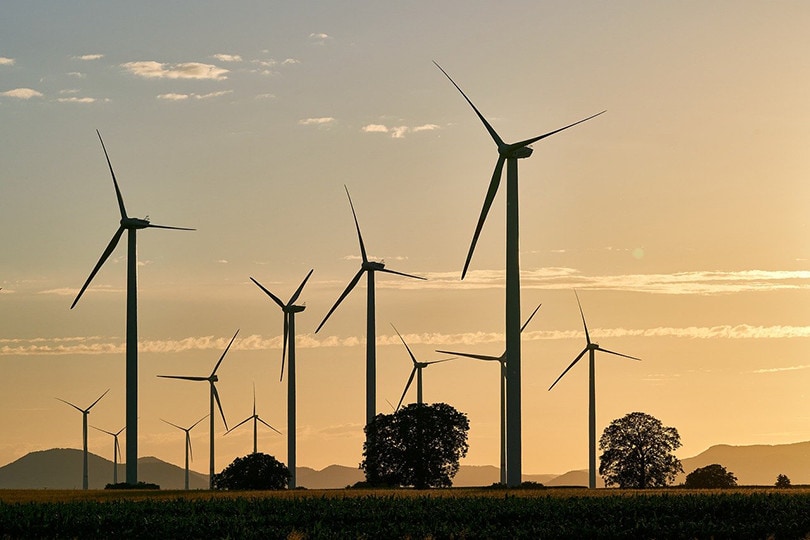
What’s the impact of wind energy on climate change?
Several factors contribute to climate change, including excess greenhouse gases in the atmosphere and changes in land use.
Using wind energy instead of fossil fuels reduces carbon dioxide (CO2) and other greenhouse gas emissions.
Wind energy is a natural resource that has a crucial part to play in the global effort to conserve the environment. It’s not only eco-friendly but also clean, affordable energy for millions of people.
(EIA)
How is wind energy generated?
Wind energy is a clean source of energy that can be harnessed to produce electricity. It has many benefits such as low production cost and environmental friendliness. It has been used for centuries and is considered a free source of power.
Wind energy uses the natural processes of the earth to produce energy. It’s an alternative to fossil fuels, nuclear power, and other renewable energies such as solar and geothermal. It does not produce harmful emissions or wastes.
The energy is produced when airflow over the earth’s surface increases rapidly from a low-pressure system and turns into the wind. This high-speed wind then travels across open country and passes through wind turbines to turn the blades. The turning blades drive generators that produce electricity.
Mechanical power can be transformed into electrical power in different ways. It includes generators that rotate in the wind and produce electrical current or steam turbines that spin a shaft connected to an electric generator.
Wind energy is a major power supply to homes and businesses around the world. Wind turbines can also drive pumps that create water flow, which is useful in agriculture.
Turbines are not only found on land but also in oceans and lakes. In the oceans, they are used to create waves for surfing, wakeboarding, and other water sports. Lakes created by dams with wind turbines can be used for boating.
Water pumps driven by wind turbines can be used by farmers to irrigate their fields. Also, using the wind to pump water up a hill and then letting it run down again can be a form of hydroelectric energy.
(CLEAN ENERGY COUNCIL)
Related Read: 10 Renewable Energy Facts and Statistics
Conclusion
Although wind energy has been used for a long time, it has become more popular recently as the technology has evolved and costs have been reduced. It is now one of the fastest-growing energy production industries.
Also, it’ll remain that way for the foreseeable future. The development of more advanced features will only make this renewable resource more attractive to our society.
Hopefully, you’ve gained some insight into the growing world of wind power. And who knows? Maybe you’re even inspired to make some green choices in your life. Either way, we hope that we’ve been able to clear up any misconceptions you may have had about this renewable source of energy.
Featured Image Credit: hpgruesen, Pixabay
Contents


